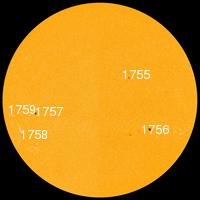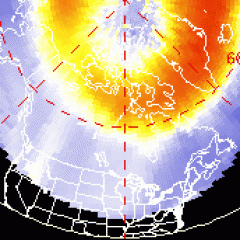SOLAR WIND STORM: For the third day in a row, a remarkably fast (600 km/s - 700 km/s) stream of solar wind is blowing around Earth. This is causing magnetic unrest around the poles as well as elevated levels of high-energy electrons in Earth orbit. NOAA cautions satellite operators that "satellite systems may experience significant charging" in response to accumulated electrons. SWx alerts: text, voice.
BEAUTIFUL VENUS-JUPITER PAIRING: The sunset triangle of May 26th is breaking up, but the show is not over. As the triple conjunction disperses, Venus is passing Jupiter only 1 degree away. Watching the two brightest planets move so close together is a wonderful way to end the day. Look west at sunset! NASA: video, full story.
Pictures of Sunday's night's triangular conjunction are still pouring in. This one shows Pat and Fred Espenak watching the show from the sky deck of Bifrost Astronomical Observatory:
"The planets Jupiter, Venus and Mercury (left to right) formed a conspicuous triangle during evening twilight on May 26th," says Fred. "This is the climax of a several-week-long triple planetary alignment as all three bright planets appear together in the evening sky."
"To see how the event will change in the nights ahead," he adds, "I've prepared some viewing charts."

![]()
Solar wind
speed: 614.8 km/sec
density: 0.3 protons/cm3
explanation | more data
Updated: Today at 2143 UT
![]()
X-ray Solar Flares
6-hr max: B3 2026 UT May28
24-hr: B9 0447 UT May28
explanation | more data
Updated: Today at: 2100 UT
![]()
![]()
![]()
Daily Sun: 28 May 13
![]()
![]()
None of these magnetically-simple sunspots poses a threat for strong solar flares. Credit: SDO/HMI
![]()
![]()
![]()
Sunspot number: 87
What is the sunspot number?
Updated 28 May 2013
Spotless Days
Current Stretch: 0 days
2013 total: 0 days (0%)
2012 total: 0 days (0%)
2011 total: 2 days (<1%)
2010 total: 51 days (14%)
2009 total: 260 days (71%)
Since 2004: 821 days
Typical Solar Min: 486 days
Update 28 May 2013
The Radio Sun
10.7 cm flux: 110 sfu
explanation | more data
Updated 28 May 2013
![]()
![]()
![]()
Current Auroral Oval:
![]()
![]()
Switch to: Europe, USA, New Zealand, Antarctica
Credit: NOAA/POES
![]()
![]()
![]()
Planetary K-index
Now: Kp= 1 quiet
24-hr max: Kp= 3 quiet
explanation | more data
![]()
Interplanetary Mag. Field
Btotal: 3.1 nT
Bz: 0.9 nT north
explanation | more data
Updated: Today at 1634 UT
![]()
![]()
![]()
Coronal Holes: 28 May 13
![]()
![]()
Solar wind flowing from this coronal hole should hit Earth's magnetic field on June 2-3. Credit: SDO/AIA.





